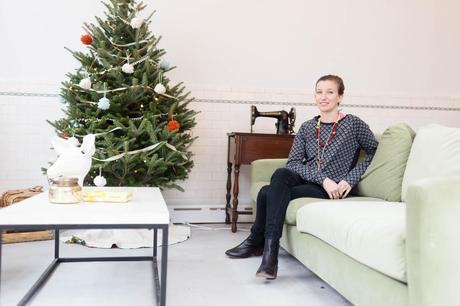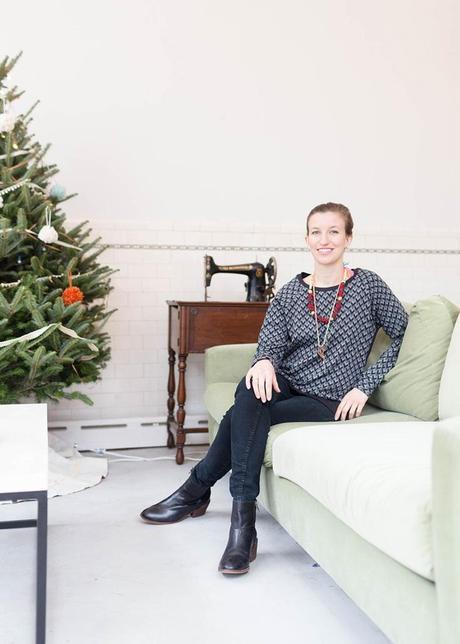
In the last 50 years, sewing has undergone an evolution. A necessity for women in the early 20th century, it transitioned from a chore to an almost obsolete hobby during by the 1980s. There was a lull in the 90s where sewing moved neither forwards nor backwards, but in the past few years, maybe even decade, it has grown into an intriguing life skill, like an item to put on one’s bucket list. People are eager to learn a trade that has an intimate, fond history, especially if their mother, grandmother or member of their family sewed. Amalia is the owner of Butcher’s Sew Shop, a studio space that offers sewing classes of all levels for adults and children and focuses on teaching students how to make professional looking pieces at home. Coming from a lineage of sewers, Amalia first started a career in the non-profit sector, but her sewing DNA seeped slowly through her veins. On nights and weekends, she kept up on her heritaged hobby and sewed. The urge to start something new ran rampant when she walked by a closed-up shop in Philadelphia’s Bella Vista neighborhood. With a beautiful, marbled doorstep, the building called to her. She took a chance, and got the place. Once renovations began, she came to understand that it was once a highly regarded meat store -“Guarrera’s Quality Meats” had been a Philadelphia establishment for 80 years. She uncovered many of the design elements from the 1920s, which only adds to its charm. Open for just six months, it’s become an establishment in the neighborhood. As I was interviewing Amalia, a local stopped in to say hello and admire her Christmas tree. Oh, and it’s also where one of my favorite sewing ladies, Andrea, works (hey pretty lady!).
While this series, Handmade, started as an evolution of Portrait of a Seamstress, each post naturally highlighted the person more than the business. So, I’m switching gears going forward and picking up Portrait of a Seamstress where it left off. Of course, if one installment becomes more about the biz than that particular subject, it will become a Handmade post.
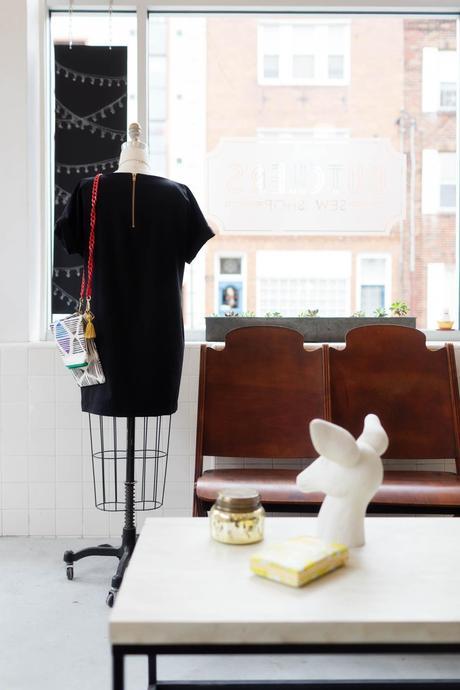
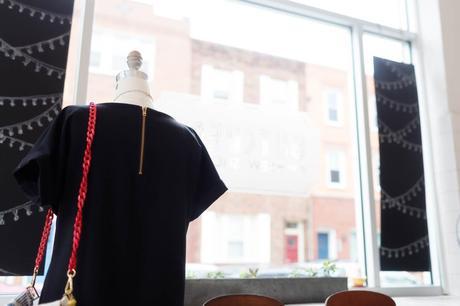
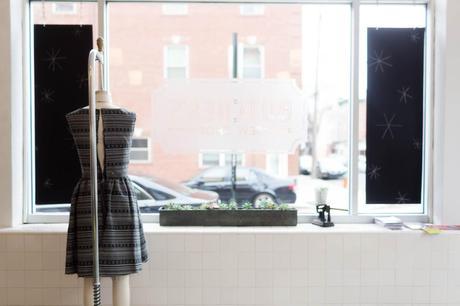
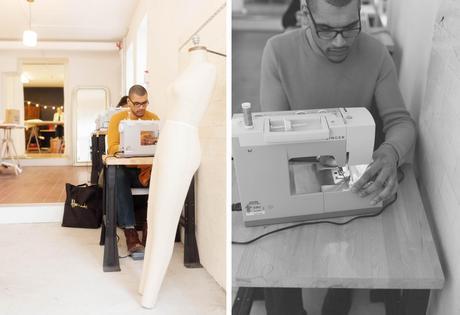

For as long as I can remember, I’ve sewed. My stepmom was a quilter and I vividly remember helping her hand sew squares together at the age of six or seven. It was a rainy weekend when I made the leap to garments. I spontaneously decided that I was going to reinvent my koala bear by making her a new wardrobe. I made a pinafore with a pleated skirt. Her name is Nutsy and I still have her. It is one of my favorite me-mades to date and certainly one of my most ambitious!
My passion naturally grew from then on. My dad studies traditional textile manufacturing in Southeast and Central Asia, so being around beautiful fabrics as a child fueled my growth. My aunt gave me a PFAFF sewing machine for my high school graduation (I still have it!).
I went to school for anthropology at Bryn Mawr College. When I went into the working world, I kept getting drawn back to sewing. I eventually quit my job and went back to school at Moore College of Art and Design. I had various interests in design – costumes and patternmaking were two – but when I started teaching, I knew that’s where I wanted my focus to go. I love sharing the feeling with someone when they complete a garment or project.
I was having my car fixed at an auto repair up the street when I first walked by the this space. It was boarded up with a “for rent” sign, but the marble tile at the front step was too beautiful not to notice. I looked in the window, saw the ceiling tile, and became totally obsessed. I didn’t realize it was originally a butcher shop. I started putting the pieces together during renovations when I could see that this wasn’t just an ordinary building. I went on ancestry.com and learned that it was Philadelphia’s premiere butcher store and was family owned until the 1990s. It had a legacy of being a place where people make a living by trade (or with their hands) and I wanted to continue that tradition. Hence the name.

First is my mom. She is a pipe organ builder and that is how she supported our family growing up. Her work ethic, passion and dedication to her trade was a good example when I started Butcher’s. It’s scary venturing off on your own, and I don’t think I would have had the courage without knowing that she did it too.
Patricia Stewart, who was a professor at Moore College of Art and Design, was another mentor. Can I say that she was really kick ass? She was a powerful person who took charge. Her knowledge of pattern making and sewing was incredible and she had a huge influence on my work.
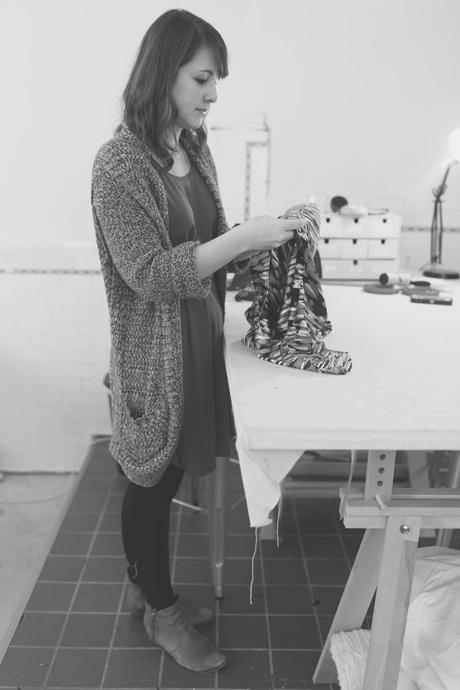
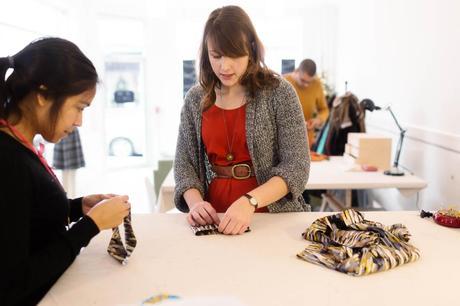
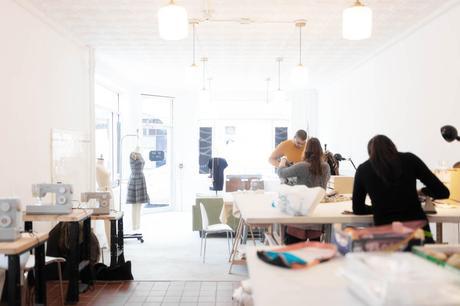

Everyone I have taught has been a great student; I don’t have any horror stories to tell. As far as a memorable one, I have two. First, there are a group of women I’m currently teaching who grew up in the neighborhood and remember coming to the butcher shop with their mom or family to buy meat. It’s wonderful knowing that they can relive their memory in a new light. The other one is a woman who always wanted to go into fashion design, but didn’t because her dad didn’t approve. She recently took up sewing and finally feels like she’s doing what she was always meant to do.

Besides Nutsy’s dress, I just finished sewing a plaid, wool bomber jacket that I’m pretty proud of. I used a Burda pattern, and the process of making it was a learning experience. Of course, I decided to sew the welt pockets after the garment was almost compkete, which wasn’t a smart move. I definitely want to make another.

Curiosity and persistence. You want to figure it out until you get it right. You could be a good sewer without it, but I think at some point, you’d stop enjoying it.
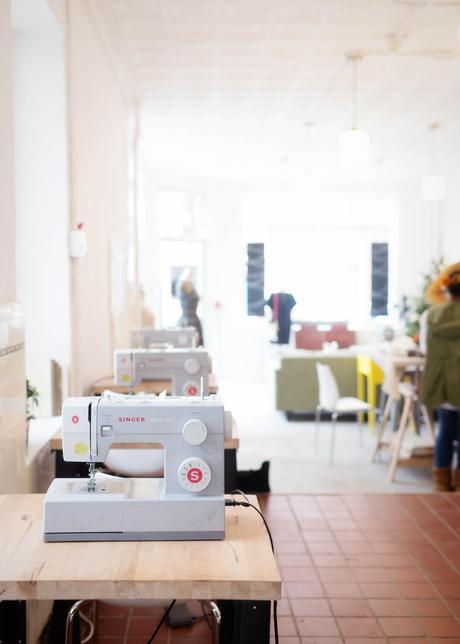

Patience! Even if you know everything about sewing, if you don’t have patience, your students won’t learn. It’s also important that a teacher meets a student at whatever level he or she is at. This is easy to do with children, whose brains are still a sponge and absorb everything and anything, but with adults, it can be difficult. Some are used to working with their hands while others aren’t, and some have a knowledgebase of sewing that you have to work with. Last, it’s important to be able to adapt your goals to meet a student’s. You might have an objective for a lesson, but the student might have a different goal, and as a teacher, you have to change yours to align with the theirs.
Okay, I have one more! It’s also crucial to foster an environment that accepts mistakes. Being mostly self-taught, I’ve learned through trial and error. A lot of newbies have an expectation that their first stab at a pattern will be perfect, when in reality, it’s the second or third time that it comes close to that (is anything ever perfect?).

If two things go wrong in succession, walk away! Give it some time and then come back to it.

